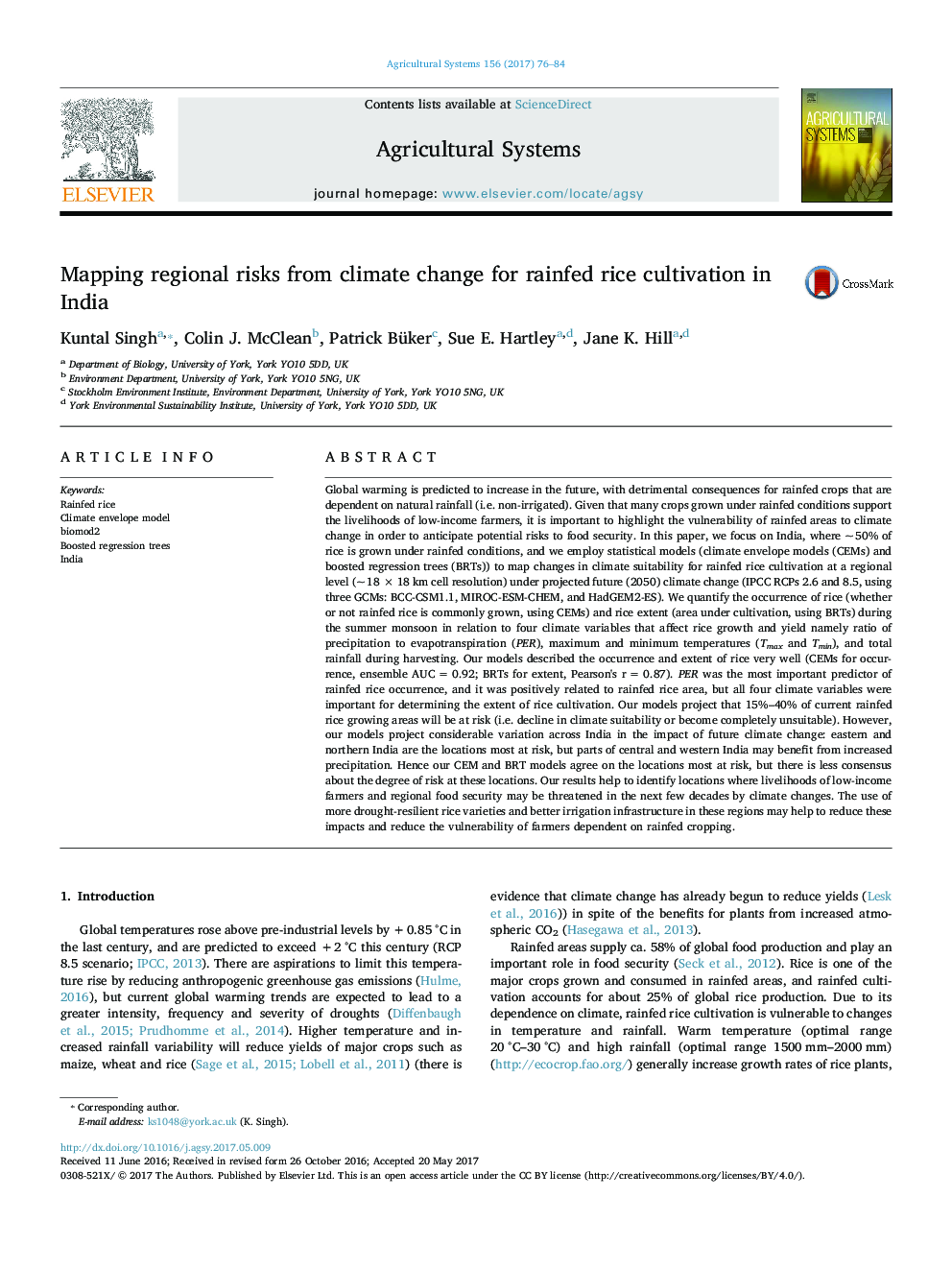| کد مقاله | کد نشریه | سال انتشار | مقاله انگلیسی | نسخه تمام متن |
|---|---|---|---|---|
| 5759695 | 1623214 | 2017 | 9 صفحه PDF | دانلود رایگان |
عنوان انگلیسی مقاله ISI
Mapping regional risks from climate change for rainfed rice cultivation in India
ترجمه فارسی عنوان
نقشه برداری خطرات منطقه ای از تغییرات آب و هوایی برای کشت برنج در هند
دانلود مقاله + سفارش ترجمه
دانلود مقاله ISI انگلیسی
رایگان برای ایرانیان
کلمات کلیدی
موضوعات مرتبط
علوم زیستی و بیوفناوری
علوم کشاورزی و بیولوژیک
علوم کشاورزی و بیولوژیک (عمومی)
چکیده انگلیسی
Global warming is predicted to increase in the future, with detrimental consequences for rainfed crops that are dependent on natural rainfall (i.e. non-irrigated). Given that many crops grown under rainfed conditions support the livelihoods of low-income farmers, it is important to highlight the vulnerability of rainfed areas to climate change in order to anticipate potential risks to food security. In this paper, we focus on India, where ~ 50% of rice is grown under rainfed conditions, and we employ statistical models (climate envelope models (CEMs) and boosted regression trees (BRTs)) to map changes in climate suitability for rainfed rice cultivation at a regional level (~ 18 Ã 18 km cell resolution) under projected future (2050) climate change (IPCC RCPs 2.6 and 8.5, using three GCMs: BCC-CSM1.1, MIROC-ESM-CHEM, and HadGEM2-ES). We quantify the occurrence of rice (whether or not rainfed rice is commonly grown, using CEMs) and rice extent (area under cultivation, using BRTs) during the summer monsoon in relation to four climate variables that affect rice growth and yield namely ratio of precipitation to evapotranspiration (PER), maximum and minimum temperatures (Tmax and Tmin), and total rainfall during harvesting. Our models described the occurrence and extent of rice very well (CEMs for occurrence, ensemble AUC = 0.92; BRTs for extent, Pearson's r = 0.87). PER was the most important predictor of rainfed rice occurrence, and it was positively related to rainfed rice area, but all four climate variables were important for determining the extent of rice cultivation. Our models project that 15%-40% of current rainfed rice growing areas will be at risk (i.e. decline in climate suitability or become completely unsuitable). However, our models project considerable variation across India in the impact of future climate change: eastern and northern India are the locations most at risk, but parts of central and western India may benefit from increased precipitation. Hence our CEM and BRT models agree on the locations most at risk, but there is less consensus about the degree of risk at these locations. Our results help to identify locations where livelihoods of low-income farmers and regional food security may be threatened in the next few decades by climate changes. The use of more drought-resilient rice varieties and better irrigation infrastructure in these regions may help to reduce these impacts and reduce the vulnerability of farmers dependent on rainfed cropping.
ناشر
Database: Elsevier - ScienceDirect (ساینس دایرکت)
Journal: Agricultural Systems - Volume 156, September 2017, Pages 76-84
Journal: Agricultural Systems - Volume 156, September 2017, Pages 76-84
نویسندگان
Kuntal Singh, Colin J. McClean, Patrick Büker, Sue E. Hartley, Jane K. Hill,
